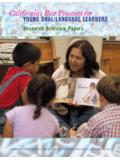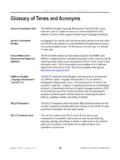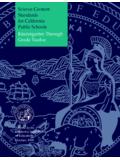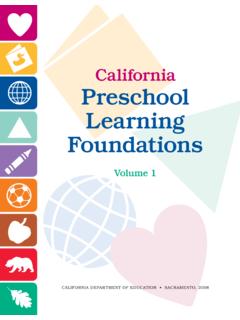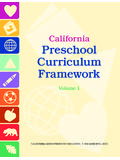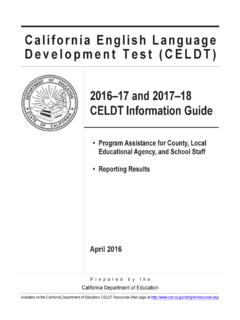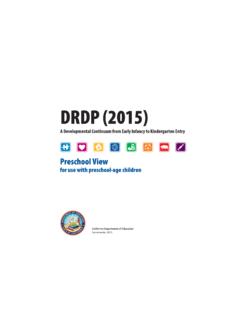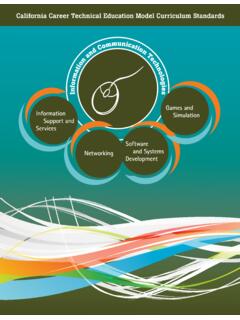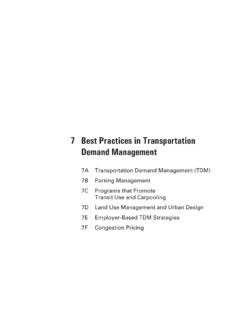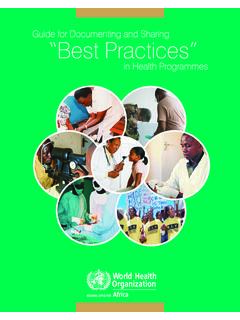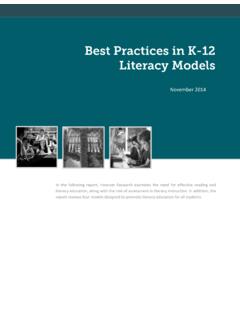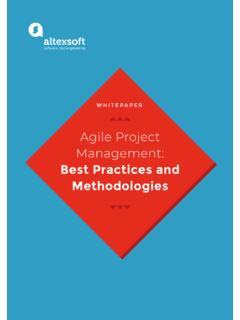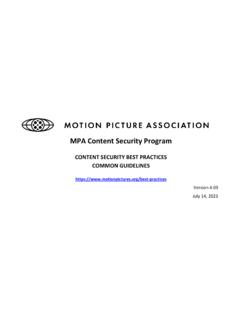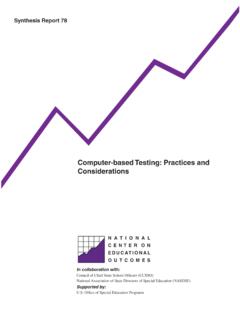Transcription of BEST PRACTICES FOR PLANNING CURRICULUM FOR YOUNG …
1 best PRACTICES FOR PLANNING CURRICULUM FOR YOUNG CHILDRENC alifornia department of education Sacramento, 2016 Publishing InformationThe Integrated Nature of Learning was developed by the Early education and Support Division, california department of education . This publication was edited by Faye Ong, working in cooperation with Laura Bridges Nieuwenhuyse, Child Development Consultant. It was designed and prepared for printing by the staff of CDE Press, with the cover designed by Tuyet Truong. It was published by the department of education , 1430 N Street, Sacramento, CA 95814. It was distributed under the provisions of the Library Distribution Act and Government Code Section 11096. 2016 by the california department of EducationAll rights 978-0-8011-1776 Reproduction of this document for resale, in whole or in part, is not Publications and Educational ResourcesFor information about publications and educational resources available from the california department of education (CDE), visit or call the CDE Press sales office at guidance in The Integrated Nature of Learning is not binding on local educational agencies or other entities.
2 Except for the statutes, regulations, and court decisions that are referenced herein, the document is exemplary, and compliance with it is not mandatory. (See education Code Section ) best PRACTICES FOR PLANNING CURRICULUM FOR YOUNG CHILDRENC alifornia department of education Sacramento, 2016 CONTENTSA Message from the State Superintendent of Public Instruction ..viAcknowledgments ..viiIntroduction ..1 Part I. Play, Learning, and CURRICULUM : How They Fit Together ..3 How YOUNG Children Learn: What Science Reveals .. 4 Play as a Context for Building Knowledge .. 9 Integrated CURRICULUM ..14 Learning Occurs in Relationships ..16 How Teachers Support Children s Active Meaning-Making ..19 Part II. Early Childhood CURRICULUM : A Broad Definition ..22 CURRICULUM Occurs Throughout the Day.
3 24 Play Spaces as CURRICULUM ..25 Daily Routines as CURRICULUM ..29 Interaction and Conversation as CURRICULUM ..32 Contexts for Written Plans ..36 Part III. Reflective PLANNING ..42 A Cycle of Observing, Documenting, and Interpreting ..43 Observe and Reflect ..44 Document to Hold in Interpret the Documentation ..48iv | The Integrated Nature of LearningContents | vPart IV. CURRICULUM That Reflects Children s Lives ..51 Dynamic ..52 Co-Constructed ..53 Responsive ..54 Part V. Assessment ..58 Documentation as Ongoing Interpretation of Learning ..59 Documentation and Periodic Standardized Assessment ..60 Glossary ..64 References ..66A Message from the State Superintendent of Public InstructionI am pleased to present The Integrated Nature of Learning, a publication providing early childhood education program administrators and teachers with guidance on PRACTICES that support an integrated approach to CURRICULUM PLANNING .
4 Research shows that learning for YOUNG children often leads to the acquisition of knowledge and skills across several domains. The idea that domains overlap and influence each other is the subject of this publica-tion. It addresses a key question: How can early educators put the idea of integrated learning into practice? Research recommends an interdisciplinary approach to devel-opmental domains. For example, a learning activity may focus on a deep exploration of a mathematical concept while also supporting the language and literacy and socio-emotional competencies that come into play during the overall learning experience. Designed to complement the other resources of the california department of Educa-tion s Early Learning and Development System, this publication examines how play, learning, and CURRICULUM work together in early education .
5 It describes the relationship context for early learning and the role of the teacher in supporting children s active engagement in learning. Strategies for guiding YOUNG children s learning taken from the california Infant/Toddler CURRICULUM Framework and the california Preschool CURRICULUM Framework, Volumes One, Two, and Three are discussed. This discussion illuminates ways in which learning experiences in one domain may also foster learning in other domains. The Integrated Nature of Learning draws both upon current research and evidence- based practice. This publication reflects the kind of early education PRACTICES that promote integrated learning in all domains with richness and depth. The result is high-quality early learning experiences that contribute to children s well-being and successful development.
6 Tom TorlaksonState Superintendent of Public Instruction vi | The Integrated Nature of LearningACKNOWLEDGMENTSThe development of The Integrated Nature of Learning involved many people. The fol-lowing groups contributed: project leader, principal writers, universal design advisers, project staff and advisers from the WestEd Center for Child and Family Studies; staff from the california department of education (CDE); early childhood education stake-holder organizations; and participants in the formative and review focus LeadersPeter L. Mangione, WestEd Katie Monahan, WestEdPrincipal Writers Special thanks are extended to the principal writers for their expertise and Jane Maguire-Fong, American River College Peter L. Mangione, WestEdUniversal Design AdvisersThe following universal design expert is gratefully acknowledged for her contributions:Linda Brault, WestEdWestEd Center for Child and Family Studies Project Staff and AdvisersMelinda BrookshireJenae LeahyKatie Monahan Teresa RagsdaleAmy Schustz-AlvarezAnn-Marie Wiese california department of EducationThanks are extended to the following staff members: Richard Zeiger, Chief Deputy Superintendent of Public Instruction; Thomas Adams, Deputy Superintendent, Instruction and Learning Support Branch; Debra McMannis, Director, Early education and Support Division; Cecelia Fisher-Dahms, Administrator, Quality Improvement Acknowledgments | viiOffice, Early education and Support Division.
7 And Laura Bridges Nieuwenhuyse, Child Development Consultant, Early education and Support Division. Their revisions and recommendations are greatly appreciated. During the lengthy development process, many CDE staff members were involved at various levels. Additional thanks are extended to Gail Brodie, Heather McClellan-Brandusa, and Charles Vail, Early education and Support Childhood education Stakeholder OrganizationsRepresentatives from many statewide organizations provided input that affected various aspects of this Alliance for Children Alliance for a Better Community Asian Pacific Islander Community Action Network (APIsCAN) Association of california School Administrators Baccalaureate Pathways in Early Childhood & education (BPECE) Black Child Development Institute (BCDI), Sacramento Affiliate california Alliance of African American Educators (CAAAE) california Association for Bilingual education (CABE) california Association for the education of YOUNG Children (CAEYC)
8 california Association for Family Child Care (CAFCC) california Association of Latino Superintendents and Administrators (CALSA) california Child Care Coordinators Association (CCCCA) california Child Care Resource and Referral Network (CCCRRN) california Child Development Administrators Association (CCDAA) california Child Development Corps california Commission on Teacher Credentialing (CCTC) california Community College Early Childhood Educators (CCCECE) california Community Colleges Chancellor s Office (CCCCO) california Council for the Social Studies (CCSS) california County Superintendents Educational Services Association (CCSESA) california Early Childhood Mentor Program california Early Reading First Network california Federation of Teachers (CFT) california Head Start Association (CHSA) california Kindergarten Association (CKA) california Preschool Instructional Network (CPIN) california Professors of Early Childhood Special education (CAPECSE) california School Boards Associationviii | The Integrated Nature of LearningCalifornia Science Teachers Association (CSTA) california State PTAC alifornia State University Office of the ChancellorCalifornia Teachers AssociationCalifornians TogetherCampaign for High Quality Early Learning Standards in california (CHQELS)Child Development Policy Institute (CDPI)Child Development Training Consortium (CDTC)Children NowThe Children s CollabriumCoalition of Family Literacy in CaliforniaCouncil for Exceptional Children/ california Division for Early Childhood (Cal-DEC)
9 Council of CSU Campus Childcare (CCSUCC) CURRICULUM Alignment Project (CAP) CURRICULUM & Instruction Steering Committee (CISC)Desired Results Access ProjectEnglish Language Learners Preschool Coalition (ELLPC)Federal/State/Tribes Collaboration WorkgroupFight Crime: Invest in Kids CaliforniaFirst 5 Association of CaliforniaFirst 5 california , california Children & Families CommissionHead Start State-Based Training and Technical Assistance Office for CaliforniaInfant Development Association of california (IDA)Learning Disabilities Association of CaliforniaLos Angeles universal Preschool (LAUP)Mexican American Legal Defense and Educational Fund (MALDEF)Migrant education Even Start (MEES)Migrant Head StartNational Council of La Raza (NCLR)Packard Foundation, Children, Families, and Communities ProgramPreschool CaliforniaProfessional Association for Childhood education (PACE)Special education Administrators of County Offices (SEACO) CommitteeSpecial education Local Plan Area (SELPA)
10 CommitteeState Advisory Council on Early Learning and Care (SAC)TeenNOW CaliforniaUniversity of california , Child Care DirectorsUniversity of california , Office of the President (UCOP)Acknowledgments | ix Voices for African American Students, Inc. (VAAS) Zero to ThreePublic InputTen focus groups consisting of 115 participants provided valuable feedback on the draft authors would like to thank the following organizations for allowing photographs of staff members, children, and families to be taken on their premises:American River College Child Development Center, SacramentoBright Future Early Learning Center, OaklandChinatown Community Children s Center, San FranciscoContra Costa College Early Learning Center, San PabloEl Jard n de Los Ni os University Preparation School at california State University Channel Islands, CamarilloFriends of St.
